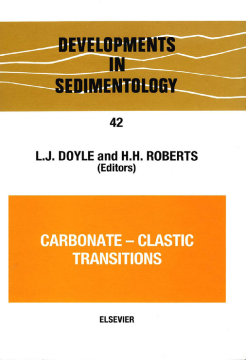
Additional Information
Book Details
Abstract
Over the years, the field of sedimentology has become subdivided into various specialities. Two of the largest groups are those who study clastic rocks and those who study carbonates. There is little communication between the two: journals appear which are exclusively devoted to one or the other, and research conferences tend to be mutually exclusive. On the other hand, rocks themselves cannot be "pigeon-holed" in this way - the facies change from clastic to carbonate both laterally and through time. This volume stems from the editors' observations of such changes in the Gulf of Mexico and their realization that these geologically important transitions were being largely ignored because of professional compartmentilization.
The book opens with a chapter which gives an overview of the whole picture of global patterns of carbonate and clastic sedimentation. It then proceeds to a discussion of sedimentary models of siliciclastic deposits and coral reef relationships. The rest of the book comprises eight case studies on carbonate-clastic transitions, and a final chapter on control of carbonate-clastic sedimentation systems by baroclinic coastal currents.
The aim of the book is to emphasize that clastic and carbonate sedimentation are not separate but part of a continuum - a transition which needs to be more thoroughly investigated and better understood. The excellent research papers presented here will undoubtedly help to achieve this goal.
D.H. Zenger
This book serves the purpose of providing in one volume a group of papers describing cases and/or models of modern associations of carbonate and clastic sediments. It fills a noticeable gap in the geologic literature....it is a welcome publication.... The volume is a valuable contribution to the sedimentological literature as it represents a benchmark for this most important subject. The editors have done a fine job in selecting papers, most of which deal with modern examples of carbonate-siliciclastic associations which provide those of us working in ancient equivalents with a number of possible analogs. It should be read by everyone involved with the subject.
Sedimentary Geology
R.P. Major
The great strength of this book is that it provides, within a single volume, a series of case studies demonstrating the close association in both time and space of clastic and carbonate rocks.... In summary, the volume fills a long-neglected niche in the literature of sedimentology and, despite some drawbacks, provides a good summary of the various controlling factors and resulting geometries of carbonate-clastic transitions... you would do well to skim through it, paying particular attention to the excellent papers by Santisteban and Taberner; Murray, Roberts, and Young; Roberts and Murray; and Hay, Rosol, Sloan, and Jory.
American Association of Petroleum Geologists
George V. Chilingar
Two of the largest subdivisions of sedimentology are clastic rocks and carbonates. There is, however, little communication between the investigators in these two fields. Yet, facies change from clastic to carbonate both laterally and through time. Drs. L.J. Doyle and H.H. Roberts realized the importance of these transitions and decided "to do something about it", which resulted in this excellent book... this book belongs on the bookshelf of every sedimentologist and reflects honor upon the editors, the authors, and the publisher.
Earth-Science Reviews
R. Leinfelder
Recently, understanding has grown that such mixed deposits are an independent unit which has to be considered and evaluated as such... This book is the first to deal solely with this interesting approach, which makes it a very long-awaited item.... an introduction and stimulation for those who enter the fascinating field of mixed sediment sequences.
Journal of Sedimentary Geology
